Reactive Programming is getting a lot of attention these days, and it promises to reduce frustration, bugs, and greenhouse gas emissions. Unfortunately, there’s a sizeable learning curve involved while you try and get your head to think in streams instead of imperative sequential processes.
In order to greatly ease the mental burden involved, I’ve created a tool that allows you to visualize the streams in real time, removing the guesswork. It’s called RxVision and you should check it out.
One of the things that caught me by suprise is the difference between hot and cold observables, and how they interact with multiple observers.
In this article, I will:
- give some background & describe the cold-induced bug
- give & explain a trivial example demonstrating this bug
- explain the bug in the larger example
- show how to fix the bug in the larger example
All with lots of visuals. Enjoy!
Learning Rx and Duplicate Ajax Calls
My first real experience playing with reactive streams was by means of @staltz’s excellent tutorial, in which you build a simple “Who to follow” box, similar to the one on twitter.

Just to make sure I really understood what was going on, I rewrote the demo in clojurescript.
Essentially, what the box does is get the users.json list from github (at a random offset), and randomly pick 3 of the 100 in that list to display to you. Clicking x next to one of the users replaces that line with a new user (drawn from the 100). Clicking refresh triggers a request to the users.json api endpoint again, this time with a different offset.
While debugging my clojurescript version, I saw in devtools that when refresh was clicked, there were 3 ajax requests instead of one. Confused, I searched through the article, and eventually found in the comments section my answer: the issue was hot vs cold observables.
Stone cold
Cold observables essentially replicate themselves for each new observer - and this works retroactively up the chain of observables.
For a somewhat trivial example:
let btn = $('button')[0]
let clicks = Rx.Observable.fromEvent(btn, 'click')
clicks.subscribe(value => console.log('clicked!'))
let values = clicks.map(() => Math.floor(Math.random() * 10 + 2))
let less1 = values.map(value => value - 1)
let times2 = less1.map(value => value*2)
times2.subscribe(value => console.log('i got a value', value))
times2.subscribe(value => console.log('also subscribing', value))
values.subscribe(value => console.log('the original was', value))
you can follow along in the RxVision playground
You would expect that the two times2 subscriptions would return the same number, right? they don’t. Take a look at the flow of values here:
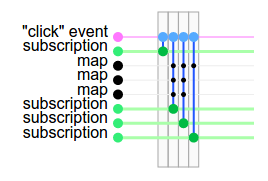
The “click” event is duplicated four times, once for each subscriber. The first map, which generates a random number, therefore generates 3 different numbers, one for each subscriber down the chain.
To fix that obvious bug, we have to make the random mapper hot, by adding .share() at the end. Line 5 now looks like:
let values = clicks.map(() => Math.floor(Math.random() * 10 + 2)).share()
This makes our console.logs give the right values, but the flow diagram still shows some duplication:

To fully deduplicate, we need to add .share() to every observable that is observed more than once (in this case, line 2 and line 7).
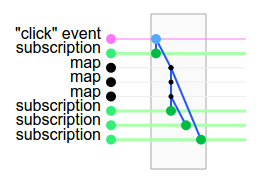
So how does this play out in a somewhat less trivial example?
Cold Multiplication
To demonstrate the issue, I ran the original demo code under the following user actions:
- load the page
- click
xnext to the first two people - click
refresh - click
xnext to the third person - click
refresh again
This is a screenshot of RxVision which visualizes the flow of values between streams.
Here, too you can follow along on the demo page I made. The code there represents the fully deduplicated version.
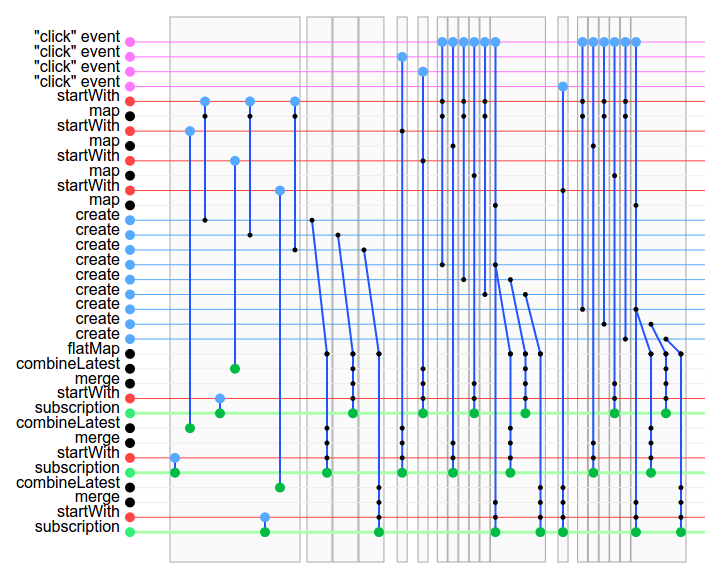
Each light gray block represents an “async group” – e.g., all of the events happened within a single tick of the js event loop.
There are lots of things going on here, so let’s dissect it:
- those blue
createstreams each represent an individual Ajax request. Within the first tick, 3 requests get fired off. You can see thestartWithobservable that initiates this pushes out the same value 3 times – this is definitely ahotvscoldproblem. - the refresh button click (the very top stream) fires off 6 times when it is clicked once. Three of those times are to clear each UI list item, and then 3 other times for our duplicated ajax calls.
Cleaning up with a little heat
As with the first example, the way to fix duplication is the .share() method of an observable. To stop the duplicate requesting, we just .share() the responseStream
var responseStream = requestStream.flatMap(ajaxGet).share();
That was easy. Now it looks like this:
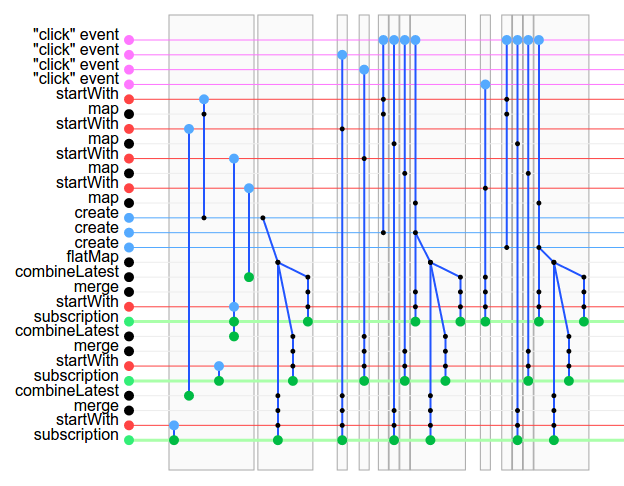
Note that there are now only 3 ajax requests (the create streams), one for the initial and two more for the times we clicked refresh. However, the refresh button click handler is still duplicating, so we need to share() that too:
var refreshClickStream = Rx.Observable.fromEvent(refreshButton, 'click').share();
The data flow chart now looks much cleaner, and duplication has been eliminated.
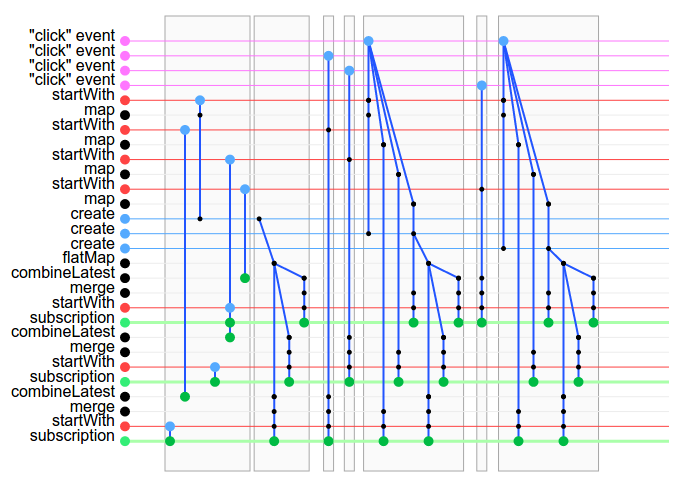
What have we learned?
- It’s easier to debug something you can look at.
- Whenever an observable is subscribed to more than once, make it hot with
.share()to make all subscribers see the same thing.
Thanks for your time, and if you check out RxVision, let me know what you think!